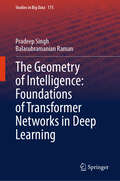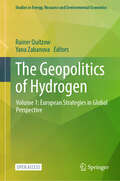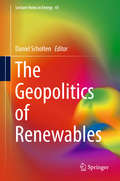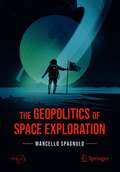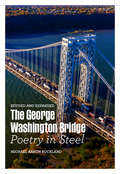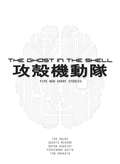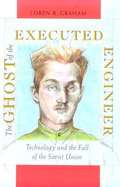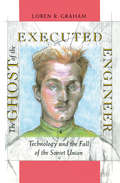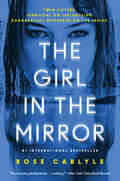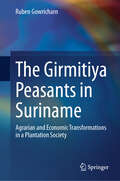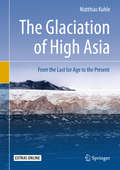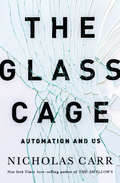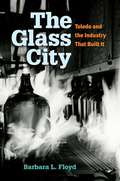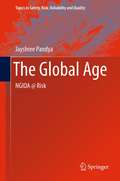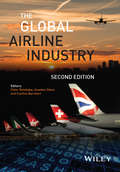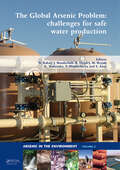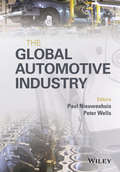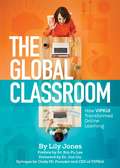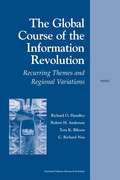- Table View
- List View
The Geology of the Belingwe Greenstone Belt, Zimbabwe: A study of Archaean continental crust
by A. Martin M.J. Bickle E.G. Nisbet J.L. OrpenA study on the Bellingwe Greenstone Belt, presenting the stratigraphy of the belt, its structure and tectonic setting, the sedimentology of what may be a rift basin, the geochemistry of the freshest Archaean komatiites yet found, and models of the evolution of the region.
The Geometry of Intelligence: Foundations of Transformer Networks in Deep Learning (Studies in Big Data #175)
by Balasubramanian Raman Pradeep SinghThis book offers an in-depth exploration of the mathematical foundations underlying transformer networks, the cornerstone of modern AI across various domains. Unlike existing literature that focuses primarily on implementation, this work delves into the elegant geometry, symmetry, and mathematical structures that drive the success of transformers. Through rigorous analysis and theoretical insights, the book unravels the complex relationships and dependencies that these models capture, providing a comprehensive understanding of their capabilities. Designed for researchers, academics, and advanced practitioners, this text bridges the gap between practical application and theoretical exploration. Readers will gain a profound understanding of how transformers operate in abstract spaces, equipping them with the knowledge to innovate, optimize, and push the boundaries of AI. Whether you seek to deepen your expertise or pioneer the next generation of AI models, this book is an essential resource on the mathematical principles of transformers.
The Geopolitics of Hydrogen: Volume 1: European Strategies in Global Perspective (Studies in Energy, Resource and Environmental Economics)
by Rainer Quitzow Yana ZabanovaThis open access book is a comprehensive exploration of European hydrogen policy, examining its development at both the EU level and in key Member States, while also considering the geopolitical implications of the emerging hydrogen landscape. The editors begin by framing Europe's position within the global hydrogen economy and present an analytical framework for assessing EU and Member State strategies within this context. The book delves into the evolution of EU hydrogen policy since the launch of its hydrogen strategy in 2020, shedding light on significant developments and how they have been influenced by events like Russia's invasion of Ukraine. It then proceeds with in-depth chapters dedicated to key EU Member States and Norway. Each country chapter examines domestic and international hydrogen policies, offering insights into important stakeholder interests, as well as the broader energy and foreign policy considerations shaping the evolving policy landscape. Special attention is given to the international dimension of these strategies, encompassing bilateral and multilateral engagements. In the final chapter, the editors analyze the diverse national strategies and their drivers and discuss their implications for the development of a European hydrogen economy and the role of the EU as a major global player in this market. By examining the variations across Member States, the book provides valuable insights into the factors influencing progress in the hydrogen sector, both in Europe and globally. This book is a resource for policymakers, researchers, and industry professionals seeking a comprehensive understanding of European hydrogen policy and its geopolitical implications. It illuminates the complex dynamics between EU-level strategies and the approaches adopted by individual Member States, ultimately contributing to a broader comprehension of Europe's position within the global hydrogen arena.
The Geopolitics of Renewables (Lecture Notes in Energy #61)
by Daniel ScholtenRenewable energy represents a game changer for interstate energy relations. The abundant and intermittent nature of sources, possibilities for decentral generation and use of rare earth materials, and generally electric nature of distribution make renewable energy systems very different from those of fossil fuels. What do these geographic and technical characteristics imply for infrastructure topology and operations, business models, and energy markets? What are the consequences for strategic realities and policy considerations of producer, consumer, and transit countries and energy-related patterns of cooperation and conflict between them? Who are the likely winners and losers? The Geopolitics of Renewables is the first in-depth exploration of the implications for interstate energy relations of a transition towards renewable energy. Fifteen international scholars combine insights from several disciplines - international relations, geopolitics, energy security, renewable energy technology, economics, sustainability transitions, and energy policy - to establish a comprehensive overview and understanding of the emerging energy game. Focus is on contemporary developments and how they may shape the coming decades on three levels of analysis: #65533; The emerging global energy game; winners and losers #65533; Regional and bilateral energy relations of established and rising powers #65533; Infrastructure developments and governance responses The book is recommended for academics and policy makers. It offers a novel analytical framework that moves from geography and technology to economics and politics to investigate the geopolitical implications of renewable energy and provides practical illustrations and policy recommendations related to specific countries and regions such as the US, EU, China, India, OPEC, and Russia.
The Geopolitics of Space Exploration (Springer Praxis Books)
by Marcello SpagnuloThis is the tale of the modern Space Age, detailing all the risks, rewards and rivalries that have fueled space exploration over the decades. Jump into a world of ambitious entrepreneurs and determined spacefaring nations, of secret spy satellites and espionage, of all the cooperative and competing interests vying for dominance in ways little known to the public. Written by an Italian aeronautical engineer with over thirty years of experience in government and private industry, this English translation explains how and why the game has fundamentally evolved and where it is headed next. Exploring such topics as GPS and cyberspace, the economics of private and public industry and the political motivations of emerging spacefaring powerhouses like China, this book is an engaging foray into the ongoing battle for our terrestrial home through extraterrestrial means.
The George Washington Bridge: Poetry in Steel
by Michael Aaron RocklandSince opening in 1931, the George Washington Bridge, linking New York and New Jersey, has become the busiest bridge in the world, with 103 million vehicles crossing it in 2016. Many people also consider it the most beautiful bridge in the world, yet remarkably little has been written about this majestic structure. Intimate and engaging, this revised and expanded edition of Michael Rockland's rich narrative presents perspectives on the GWB, as it is often called, that span history, architecture, engineering, transportation, design, the arts, politics, and even post-9/11 mentalities. This new edition brings new insight since its initial publication in 2008, including a new chapter on the infamous “Bridgegate” Chris Christie-era scandal of 2013, when members of the governor's administration shut down access to the bridge, causing a major traffic jam and scandal and subsequently helping undermine Christie’s candidacy for the US presidency. Stunning photos, from when the bridge was built in the late 1920s through the present, are a powerful complement to the bridge's history. Rockland covers the competition between the GWB and the Brooklyn Bridge that parallels the rivalry between New Jersey and New York City. Readers will learn about the Swiss immigrant Othmar Ammann, an unsung hero who designed and built the GWB, and how a lack of funding during the Depression dictated the iconic, uncovered steel beams of its towers, which we admire today. There are chapters discussing accidents on the bridge, such as an airplane crash landing in the westbound lanes and the sad story of suicides off its span; the appearance of the bridge in media and the arts; and Rockland's personal adventures on the bridge, including scaling its massive towers on a cable. Movies, television shows, songs, novels, countless images, and even PlayStation 2 games have aided the GWB in becoming a part of the global popular culture. This tribute will captivate residents living in the shadow of the GWB, the millions who walk, jog, bike, skate, or drive across it, as well as tourists and those who will visit it someday. .
The Ghost in the Shell
by Gakuto Mikumo Kafka Asagiri Toh Enjoe Tow Ubukata Yoshinobu AkitaNeither a utopia nor a dystopia, it’s still a world of nations at strife, as dominated by corporations as ever. Technology hasn’t made humans nearly obsolete, but rather bettered us, if you will, attaching to our bodies and even brains as enhancements—for those who can afford it.Comics artist Shirow Masamune’s vision of our coming society, animated to global acclaim and finally the basis of a major Hollywood production, branches out in five original stories by some of the most beloved SF novelists working in Japan today. A standalone collection, it requires no familiarity with the franchise to be enjoyed but is indispensable for fans for its thoughtful exploration of the series’ implications.While reality may never become virtual, it will be increasingly networked and augmented. Navigate herein age-old questions about man that will return, not so ironically, in full force: What is the self? Is there such a thing as the soul?
The Ghost of the Executed Engineer: Technology and the Fall of the Soviet Union (Russian Research Center Studies #87)
by Loren R. GrahamStalin ordered his execution, but here Peter Palchinsky has the last word. Palchinsky tells of Soviet technology and industry, the mistakes he condemned in his lifetime, the corruption and collapse he predicted, the ultimate price paid for silencing those who were not afraid to speak out. The story of this visionary engineer's life and work, as Graham tells it, is also the story of the Soviet Union's industrial promise and failure.
The Ghost of the Executed Engineer: Technology and the Fall of the Soviet Union (Russian Research Center studies ; #No. 87)
by Loren GrahamStalin ordered his execution, but here Peter Palchinsky has the last word. As if rising from an uneasy grave, Palchinsky’s ghost leads us through the miasma of Soviet technology and industry, pointing out the mistakes he condemned in his time, the corruption and collapse he predicted, the ultimate price paid for silencing those who were not afraid to speak out. The story of this visionary engineer’s life and work, as Loren Graham relates it, is also the story of the Soviet Union’s industrial promise and failure. We meet Palchinsky in pre-Revolutionary Russia, immersed in protests against the miserable lot of laborers in the tsarist state, protests destined to echo ironically during the Soviet worker’s paradise. Exiled from the country, pardoned and welcomed back at the outbreak of World War I, the engineer joined the ranks of the Revolutionary government, only to find it no more open to criticism than the previous regime. His turbulent career offers us a window on debates over industrialization. Graham highlights the harsh irrationalities built into the Soviet system—the world’s most inefficient steel mill in Magnitogorsk, the gigantic and ill-conceived hydroelectric plant on the Dnieper River, the infamously cruel and mislocated construction of the White Sea Canal. Time and again, we see the effects of policies that ignore not only the workers’ and consumers’ needs but also sound management and engineering precepts. And we see Palchinsky’s criticism and advice, persistently given, consistently ignored, continue to haunt the Soviet Union right up to its dissolution in 1991. The story of a man whose gifts and character set him in the path of history, The Ghost of the Executed Engineer is also a cautionary tale about the fate of an engineering that disregards social and human issues.
The Girl Before
by Jp DelaneyEnter the world of One Folgate Street and discover perfection . . . but can you pay the price? <p><p>Jane stumbles on the rental opportunity of a lifetime: the chance to live in a beautiful ultra-minimalist house designed by an enigmatic architect, on condition she abides by a long list of exacting rules. <p><p>After moving in, she makes a shocking discovery about the previous tenant, Emma, and Jane starts to wonder if her own story will be a rerun of the girl before.
The Girl Before: The addictive thriller that has sold a million copies - now a major must-watch TV series
by JP DelaneyTHE ADDICTIVE THRILLER THAT HAS SOLD OVER A MILLION COPIES WORLDWIDE*********Enter the world of One Folgate Street and discover perfection . . . but can you pay the price?Jane stumbles on the rental opportunity of a lifetime: the chance to live in a beautiful ultra-minimalist house designed by an enigmatic architect, on condition she abides by a long list of exacting rules.After moving in, she makes a shocking discovery about the previous tenant, Emma, and Jane starts to wonder if her own story will be a rerun of the girl before.'A must-read' ⭐⭐⭐⭐⭐ READER REVIEW***********NOW A MAJOR TV SERIESTHE SUNDAY TIMES AND NEW YORK TIMES BESTSELLERSHORTLISTED FOR THE BRITISH BOOK AWARDS CRIME & THRILLER BOOK OF THE YEARTHE SUNDAY TIMES THRILLER OF THE MONTHTHE SIMON MAYO RADIO 2 BOOK CLUB PICK***********'DAZZLING' - Lee Child'ADDICTIVE' - Daily Express'DEVASTATING' - Daily Mail'INGENIOUS' - The New York Times'COMPULSIVE' - Glamour Magazine'ELEGANT' - Peter James'SEXY' - Mail on Sunday'ENTHRALLING' - Woman and Home'ORIGINAL' - The Times'RIVETING' - Lisa Gardner'CREEPY' - Heat'SATISFYING' - Reader's Digest'SUPERIOR' - The Bookseller
The Girl Who Codes
by Rachel SarahMae Foster is a young girl who loves to code! She is super excited to join her school’s Coding Club but feels guilty about leaving her sick mother at home. Can she figure out a way to continue coding and help her mother at the same time?
The Girl in the Mirror: A Novel
by Rose CarlyleInstant #1 International Bestseller“Cue greed, lust, secrets, and serious suspense. Count us in.”—theSkimm"An insanely plotted book...riveting."—The New York Times Book ReviewWritten with the chilling, twisty suspense of The Wife Between Us and Something in the Water, a seductive thriller about identical twins, greed, lust, secrets, and deadly lies.Twin sisters Iris and Summer are startlingly alike, but beyond what the eye can see lies a darkness that sets them apart. Cynical and insecure, Iris has long been envious of Summer’s seemingly never-ending good fortune.When Summer calls Iris to Thailand to help her sail the family yacht to the Seychelles, Iris has secret hopes for what might happen on the journey. But after a disturbing incident in the middle of the Indian Ocean, everything changes.Now Iris has the chance to step into the golden life she’s always envied–and get one step closer to the hundred-million-dollar inheritance left by her manipulative father. All Iris would need to do is ensure she’s the first of his seven children to fulfill the strange conditions of his will.But Iris soon discovers that her twin was keeping more than one secret, and Iris’s life lurches between glamorous dream and paranoid nightmare. In a family in which the winner takes all, whom can she trust? And how far will she go to get the life she’s always dreamed about?"Ferociously entertaining. A novel like a triathlon: part evil-twin thriller, part howdunit (or did-she-do-it?), part juicy family drama. Drop Knives Out and Double Indemnity into the blender, shake some Dead Calm over the froth, power it on, and you’ve got a cocktail like The Girl in the Mirror—fresh, flavorful, and utterly intoxicating." —AJ Finn, #1 New York Times bestselling author of The Woman in the Window
The Girmitiya Peasants in Suriname: Agrarian and Economic Transformations in a Plantation Society
by Ruben GowricharnThis book examines the Indo-Surinamese Girmitiya peasants and their contributions to developing the ethnic community within their newly adopted home. It demonstrates the transformation of the Girmitiyas from agriculturalists in British India to plantation labourers to peasants and finally to urban dwellers. The author argues that it was the Girmitiya peasants who had made greater contributions to developing the ethnic community over the labourers of whom about one-third returned to British India. The work covers the history of how the peasants institutionalised their practice, changed the physical landscape and integrated economically and politically as an ethnic group in their newly adopted homeland. Furthermore, the author presents arguments to demonstrate that Girmitiya peasants survived the plantation labour and peasant life due to their knowledge and skills of agrarian cultivation, known as agrarian human capital. The scholarly literature about the labour migration from British India has focused heavily on the fate of the labourers. Consequently, the history of the Girmitiya peasants as well as the cultural heritage they have produced has been grossly neglected. This book purports to fill this void by telling the history of Girmitiya peasants in Suriname, a Caribbean society adjacent to former British Guyana.
The Glaciation of High Asia: From the Last Ice Age to the Present (Earth Sciences In The 21st Century Ser.)
by Matthias KuhleThis book summarizes four decades of glacial-geomorphological field research in Central and High Asia in an attempt to draw a significant link between Quaternary science research and paleoclimatology. Based on the latest geomorphological findings, this study offers a large-scale reconstruction of the Last Glacial Maximum (LGM) that in High Asia encompassed a total expanse of no less than three million km2, including the Central Tibetan plateau with 2.4 million km2. The author offers a complete reconstruction of the Late Glacial, Holocene, and Historical glacier advances as well as the successive Postglacial ablation stages extending to the present. Taken together, the findings presented here provide the first insights into a global-climatic impact of the Last Glacial Maximum in Central and High Asia with respect to the current interglacial stage. The comparative data analyses point to an inland glaciation at subtropical latitude covering an area larger than the Nordic inland glaciation in Greenland. These insights are facilitated by a methodological approach, unprecedented in modern Quaternary research, that combines high-quality panoramic photography with high-resolution satellite imagery. This combination of terrestrial and aerial perspectives enables scientists and readers alike to visualize the geomorphology of the landscape as a three-dimensional space. The author’s successful union of digital big data resources with classical geomorphological analysis offers an exciting new template for future research in Quaternary science and related fields.
The Glass Cage: Automation And Us
by Nicholas CarrAt once a celebration of technology and a warning about its misuse, The Glass Cage will change the way you think about the tools you use every day. In The Glass Cage, best-selling author Nicholas Carr digs behind the headlines about factory robots and self-driving cars, wearable computers and digitized medicine, as he explores the hidden costs of granting software dominion over our work and our leisure. Even as they bring ease to our lives, these programs are stealing something essential from us. Drawing on psychological and neurological studies that underscore how tightly people's happiness and satisfaction are tied to performing hard work in the real world, Carr reveals something we already suspect: shifting our attention to computer screens can leave us disengaged and discontented. From nineteenth-century textile mills to the cockpits of modern jets, from the frozen hunting grounds of Inuit tribes to the sterile landscapes of GPS maps, The Glass Cage explores the impact of automation from a deeply human perspective, examining the personal as well as the economic consequences of our growing dependence on computers. With a characteristic blend of history and philosophy, poetry and science, Carr takes us on a journey from the work and early theory of Adam Smith and Alfred North Whitehead to the latest research into human attention, memory, and happiness, culminating in a moving meditation on how we can use technology to expand the human experience.
The Glass City: Toledo And The Industry That Built It
by Barbara Floyd Barbara L. FloydThe headline, “Where Glass is King,” emblazoned Toledo newspapers in early 1888, before factories in the Ohio city had even produced their first piece of glass. After years of struggling to find an industrial base, Toledo had attracted Edward Drummond Libbey and his struggling New England Glass Company to the shores of the Maumee River, and many felt Toledo’s potential as “The Future Great City of the World” would at last be realized. The move was successful—though not on the level some boosters envisioned—and since 1888, Toledo glass factories have employed thousands of workers who created the city’s middle class and developed technical innovations that impacted the glass industry worldwide. But as has occurred in other cities dominated by single industries—from Detroit to Pittsburgh to Youngstown—changes to the industry it built have had a devastating impact on Toledo. Today, 45 percent of all glass is manufactured in China. Well-researched yet accessible, this new book explores how the economic, cultural, and social development of the Glass City intertwined with its namesake industry and examines Toledo’s efforts to reinvent itself amidst the Midwest’s declining manufacturing sector.
The Glitch In Sleep (The\seems Ser.)
by John Hulme Michael WexlerWhen twelve-year-old Becker Drane is recruited by The Seems, a parallel universe that runs everything in The World, he must fix a disastrous glitch in the Department of Sleep that threatens the ability of everyone to ever fall asleep again.
The Global Age: NGIOA @ Risk
by Jayshree PandyaDr. Jayshree Pandya, founder of Risk Group LLC (http://www.riskgroupllc.com), is ahead of the curve in addressing the changing global fundamentals of the emerging Global Age. Global Age, and its changing global fundamentals has brought complex, chaotic, and turbulent times for every nation--where failures at all levels have come to become self-evident, repetitive, destructive, and potentially hopeless in nature and uncertainty. Nations are caught off guard. From what is visible across nations today, the promise of progress and prosperity for all nations does not seem to have materialized in a Global Age. Instead of progress and prosperity, what is visible today is crisis and catastrophe that is overpowering and overwhelming the capability of most nations to meet their promise of progress and prosperity. Nations are in crisis. This introductory book Global Age: NGIOA @ Risk addresses the global shifts and the changing global fundamentals of Global Age, to lay out much needed foundation of an integrated NGIOA risk governance framework for the coming tomorrow. This book will make a convincing case for the far-reaching need and understanding of global risk concepts, global risk fundamentals, and risk centric integrated NGIOA governance. The integrated NGIOA risk governance approach proposed and discussed in this initiative is rational, practical, and feasible. It will help create a dynamic, vibrant, and sustainable NGIOA economy of a Global Age. This initiative is a first step towards that.
The Global Airline Industry
by Cynthia Barnhart Amedeo Odoni Peter BelobabaIn today's rapidly changing air transport environment, the aviation professionals require access to advanced and comprehensive knowledge, coupled with an in-depth understanding of the needs of the airline industry. Drawing on the editors? extensive experience with airline and air transport issues, The Global Airline Industry provides a definitive introduction to our air transportation system. Featuring contributors from 3 different continents, all affiliated to MIT?s Global Airline Industry Program, this book?s unique and holistic perspective is allied with detailed coverage of air transportation economics airline planning and operations industrial relations and human resource issues aviation safety and security aviation infrastructure and environmental impacts airline pricing and distribution. The Global Airline Industry is accompanied by a book companion website hosting databases with regular updates of airline & air transport related statistics and information as well as updates of the book material, housed at www. wiley. com/belobaba. It engenders a crucial understanding of the essential parameters within which the interfacing disciplines in the industry must operate that will benefit both students in air transportation/ aviation management degree programmes as well as professionals working in the industry.
The Global Arsenic Problem: Challenges for Safe Water Production (Arsenic in the environment)
by Jochen Bundschuh Prosun Bhattacharya Marek Bryjak Nalan Kabay Bruce Hendry Kazuharu Yoshizuka Suer AnacA prevalent and increasingly important issue, arsenic removal continues to be one of the most important areas of water treatment. Conventional treatment plants may employ several methods for removing arsenic from water. Commonly used processes include oxidation, sedimentation, coagulation and filtration, lime treatment, adsorption onto sorptiv
The Global Automotive Industry
by Peter Wells Paul NieuwenhuisThe automotive industry is still one of the world's largest manufacturing sectors, but it suffers from being very technology-focused as well as being relatively short-term focused. There is little emphasis within the industry and its consultancy and analyst supply network on the broader social and economic impacts of automobility and of the sector that provides it. The Global Automotive Industry addresses this need and is a first port of call for any academic, official or consultant wanting an overview of the state of the industry. An international team of specialist researchers, both from academia and business, review and analyse the key issues that make vehicle manufacturing still the world's premier manufacturing sector, closely tied in with the fortunes of both established and newly emerging economies. In doing so, it covers issues related to manufacturing, both established practices as well as new developments; issues relating to distribution, marketing and retail, vehicle technologies and regulatory trends; and, crucially, labour practices and the people who build cars. In all this it explains both how the current situation arose and also likely future trajectories both in terms of social and regulatory trends, as the technological, marketing and labour practice responses to those, leading in many cases to the development of new business models. Key features Provides a global overview of the automotive industry, covering its current state and considering future challenges Contains contributions from international specialists in the automotive sector Presents current research and sets this in an historical and broader industry context Covers threats to the industry, including globalization, economic and environmental sustainability The Global Automotive Industry is a must-have reference for researchers and practitioners in the automotive industry and is an excellent source of information for business schools, governments, and graduate and undergraduate students in automotive engineering.
The Global Classroom: How VIPKID Transformed Online Learning
by Lily JonesBehind the Scenes of a Revolution in EducationIn 2013, Cindy Mi, a high school dropout turned English teacher, founded VIPKid with an innovative vision for education: facilitating personalized, one-on-one sessions with students and tutors from around the world. Six years later, her brainchild boasts a $3 billion valuation and connects approximately 500,000 students with 60,000 teachers worldwide. Thisis the story of a revolution in education.The Global Classroom takes readers inside the startup&’s history, educational innovation, and unprecedented success. With a foreword from Mi, the book takes a deep dive into a new educational model and investigates how the company&’s platform has diversified to serve the needs of students from countries across the globe. Readers will hear from VIPKid&’s executives, teachers, students, and parents as they discuss the company&’s values, its tangible success, and its impact on their lives.The Global Classroom is an inside look at the model for education in the 21st century and beyond.
The Global Coal Market
by Mark C. Thurber Thurber, Mark C. and Morse, Richard K. Richard K. MorseCoal has been the world's fastest-growing energy source in absolute terms for over a decade. Coal also emits more CO2 than any other fossil fuel and contributes to serious air pollution problems in many regions of the world. If we hope to satisfy the demand for affordable energy in emerging economies while protecting the environment, we need to develop a keen understanding of the market that supplies coal. This book offers an in-depth analysis of the key producers and consumers that will most influence coal production, transport, and use in the future. By exploring how countries such as China, India, Indonesia, Australia and South Africa have developed their respective coal industries - and how these industries link together through the international coal trade - experts shed light on how the global coal market may evolve, and the economic and environmental implications. This book is the most comprehensive treatment of these topics to date and will appeal to a wide readership, including scholars and practitioners working on energy economics and policy.
The Global Course of the Information Revolution
by C. Richard Neu Robert H. Anderson Tora K. Bikson Richard HundleyAdvances in information technology are heavily influencing ways in which business, society, and government work and function throughout the globe, bringing many changes to everyday life, in a process commonly termed the "information revolution." This book paints a picture of the state of the information revolution today and how it will likely progress in the near- to mid-term future (10 to 15 years), focusing separately on different regions of the world-North America, Europe, the Asia-Pacific region, Latin America, the Middle East and North Africa, and sub-Saharan Africa.

